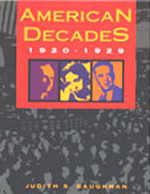The 1920s
Introduction
Profound cultural and social conflict marked the years of the 1920s. New cultural attitudes towards race, immigration and evolution, along with changes in the social fabric, pitted the new cosmopolitan culture against more traditional and conservative ideals. Social changes included the rise of consumer culture and mass entertainment in the form of radio and movies. The changing of sexual mores and gender roles marked a sharp separation from the Victorian past. Prohibition made alcohol illegal, while wild speculation in the stock market, along with unhealthy corporate structures, ensured the decade's relative prosperity would end in a Great Crash.
Jazz and tabloid journalism charted a new era of sensationalism focusing on sex and crime. While the victorious nations from the First World War enjoyed the spoils, resentment bred in Germany, setting the stage for future conflict.
In his 1925 novel The Great Gatsby, F. Scott Fitzgerald wrote: "So we beat on, boats against the current, borne back ceaselessly into the past."
Journalists and media personalities
David Sarnoff

The creator of the National Broadcasting Company who helped develop television. Sarnoff became the most powerful figure in the communications and media industries. He claimed to have scooped the world on the Titanic disaster, staying at his telegraph key for 72 hours. In 1915, he submitted a memo to the Marconi Wireless Telegraph Company of America, which granted him $2,000 to develop his idea for a "radio music box." By 1924, the box had sold $83 million worth of units. Sarnoff's chief ambition wasn't making money but enlarging the applications of the electronic media through research and development.
William S. Paley

Radio tycoon who headed the Columbia Broadcasting System. Paley was regarded as a programming genius who rewrote the nation's definition of entertainment and news. In 1928 he bought $50 worth of advertising on Philadelphia station WCAU for his father's company, La Palina Cigars. Sales skyrocketed and the family ended up buying a chain of stations, which Paley renamed the Columbia Broadcasting System (CBS). He became president of the network on September 28. He set up his own news organization and recruited a veritable dean's list of newsmen: Edward R. Murrow, William Shirer and Eric Sevareid, just to name a few.
- Paley takes over CBS (video)
Henry Luce

Henry Luce, along with Briton Hadden, launched Time magazine in 1923. The magazine developed innovative approaches to news coverage, including packaging the news in topical units and replacing standard newspaper prose with a catchy narrative style. From the start, Time was accused of bias; Luce and Hadden were conservatives who opposed government interference of business. After Hadden died in 1929, Luce went on to build a media empire that included Fortune, Life, Sports Illustrated and Time-Life books.
William Allen White

A Kansas editorial writer and newspaper owner who walked among the giants of politics, White worked fervently for the causes he believed in. White even left his newspaper, The Emporia Gazette, to run independently for governor when the two main candidates accepted endorsements from the Ku Klux Klan. White won a Pulitzer Prize in 1922 for his editorial To an Anxious Friend", defending free expression.
"You tell me that law is above freedom of utterance. And I reply that you can have no wise laws nor free entertainment of wise laws unless there is free expression of the wisdom of the people - and, alas, their folly with it. But if there is freedom, folly will die of its own poison, and the wisdom will survive." -- William Allen White, "To an Anxious Friend", July 27, 1922
Freeman Gosden and Charles Corell

The stars of America's most popular radio show, Amos ‘n' Andy. The white men did schtick based on stereotypical black men. In an era of blackface entertainment, there were no protests. The show broadcast six nights a week in 15-minute installments. So popular was the show, that America would stop from 7:00 to 7:15, movie theaters would shut off their projectors and roll out radio sets. The show retained its popularity through the 1940s.
- Corell and Gosden get their start (video)
- Amos 'n' Andy (video)
Will Rogers

The comedian and social critic rose to radio stardom in 1922. He was famous for saying, "I never met a man I didn't like." Rogers regarded Congress as his "joke factory." He became a syndicated writer whose columns appeared in more than 400 newspapers. His homespun wit made him a beloved national figure. At the 1932 Democratic National Convention, Rogers fell asleep only to wake up to find he'd been nominated for President. "If elected, I promise to resign," he said. He died in a plane crash in 1935.
- A Will Rogers clip (audio)
Osa and Martin Johnson

The Johnsons traveled the globe photographing and filming their adventures in Africa, the South Pacific and elsewhere. In order to finance their trips, the Johnsons signed contracts to advertise tobacco, soft drinks, cosmetics and coffee. Their films proved extremely popular and, for a time, Osa Johnson's popularity matched that of Eleanor Roosevelt or Ann Lindbergh.
Bernarr Macfadden

Health guru who earned his fortune from the magazine Physical Culture. Macfadden introduced the confession magazine in 1919 with True Story, which had a weekly circulation of more than 2 million. Its success was attributed largely to its sexual frankness. True Story addressed sexual problems in a clinical rather than erotic way. Realizing that the word "true" sold copies, Macfadden launched the first quasi-factual detective magazine, True Detective Mysteries, in 1924. Macfadden's magazines were profitable and innovative, but his newspapers, including the tabloid the New York Evening Graphic, failed.
- Bernarr Macfadden (video)
Walter Winchell

The most widely read columnist in American journalism. His "three-dot" column was a must-read in the New York Evening Graphic and, later, in the New York Daily Mirror. Once he said about celebrity: "To become famous, throw a brick at someone who is famous." The content of his columns broadened through time, starting with show-biz gossip and expanding to include items about politics and business. His writings spawned a journalistic genre. Winchell's greatest media exposure came from his weekly radio broadcasts, which began in 1930 with the greeting: "Good evening, Mr. And Mrs. America and all the ships at sea." After World War II, he was denounced as a fascist by the left for his strong stance against communism.
John R. "Doc" Brinkley

Originally from North Carolina, "Doctor" Brinkley, a con man with a dubious medical education, claimed he could restore male virility by implanting goat glands from his clinic in Milford, Kansas. Brinkley then opened KFKB, one the of first radio stations in the country. Unburdened by federal limitations on signal strength, Brinkley's high-powered station sold his pharmaceuticals and spread his politics nationwide. After an unsuccessful write-in campaign for the governorship of Kansas, Brinkley would move his operation to Mexico.
William Ashely "Billy" Sunday

Following a successful baseball career, Billy Sunday traded his uniform for a preacher's collar, becoming one of the most successful evangelical ministers of the early decades of the 20th century. Preaching conservative christian ideals, Sunday played a crucial role in the Prohibition movement. He would also inspire future evangelical ministers with his charismatic — and athletic — preaching style, as well as his use of radio to spread his message.
- Sunday morning radio (video)
Political scene
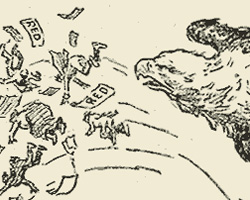
Detail from a cartoon entitled "Cleaning the Nest"
With the end of World War I came deep-seated fears of political radicalism, the beginnings of what would become the "Red Scare." Before the end of the Wilson presidency, Attorney General A. Mitchell Palmer led raids on leftist organizations such as the International Workers of the World, a labor union. Palmer hoped his crusade against radicalism would usher him into the presidency. He created the precursor to the Federal Bureau of Investigation, which collected the names of thousands of suspected Communists.
More than 500 aliens on the list were deported, including the radical orator Emma Goldman. Palmer claimed he was ridding the country of "moral perverts," but his tactics, which tended to violate civil liberties, proved to be too draconian in the minds of the electorate.
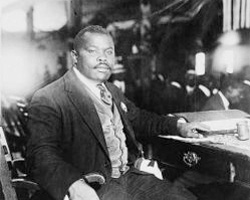
Marcus Garvey
During the early 1920s, the ranks of the Ku Klux Klan swelled to 4.5 million. The Klan helped to elect 16 U.S. Senators, as well as many Representatives and local officials. When David Curtis Stephenson, Indiana's head Klansman, was convicted of kidnapping and sexual assault in 1925, indictments and prosecutions of Klan-supported politicians on corruption charges followed. Nationwide membership of the Klan fell to just 45,000 in five years.
Marcus Garvey, the "Black Moses," led a national movement whose theme was the impossibility of equal rights in white America. Garvey preached black pride, segregation and a return to Africa, but the decade's currents of white supremacy overpowered him. He was charged with mail fraud, jailed and deported.
William Allen White, a small-town editor in Emporia, Kansas, crusaded against the Klan and for free speech. In his Pulitzer Prize-winning editorial, he wrote: "If there is freedom, folly will die of its own poison."
- William Allen White (pdf)
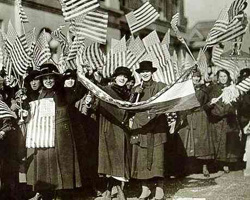
Woman celebrating the passage of the 19th Amendment.
With the passage of the 19th Amendment, women were given the right to vote in 1920, but voting remained an upper- and middle-class activity. No new opportunities in the workplace arose, and the momentum of the women's movement at the beginning of the decade was eventually swallowed by the rise of consumer culture.
Warren G. Harding, a Republican Senator from Ohio, was elected President in 1920. Under Harding, government's previous efforts to regulate business practices were relaxed in favor of a new emphasis on corporate partnerships. Best known for a series of outrageously corrupt political scandals, Harding's presidency was not without its merits. He pardoned Eugene Debs, the imprisoned Socialist Party leader; he persuaded the steel industry to enact an 8-hour workday; and he helped slow down the arms race. However, his administration was stacked with corrupt officials who gave kickbacks to the Justice Department and the Veterans Bureau. After Harding died of a stroke while still in office in 1923, the Teapot Dome scandal broke, revealed that private oil companies had been draining oil from federal lands.

Herbert Hoover
Harding's sudden demise meant his Vice President, Calvin Coolidge, held the top office. Nicknamed "Silent Cal," Coolidge was asked during the 1924 election if he had anything to say about the world situation. His reply: "No." Still, a divisive Democratic Party helped the incumbent win the election by 7 million votes.
When the Democrats nominated Al Smith, an Irish-Catholic from New York's Lower East Side, for President in 1928, the party closed ranks behind him, but economic prosperity and anti-Catholic sentiment kept Smith from being elected. He is credited with awakening a vast army of immigrants in the big cities and with shifting African-American voters toward the Democrats.
The 1928 President-elect, Herbert Hoover, envisioned a private economy that would operate mostly free from government intervention. Predicting ever-greater prosperity, he said, "We shall soon, with the help of God, be in sight of the day when poverty will be banished from this nation." But then the stock market fell out from under him.
- Hoover elected (video)
Social climate
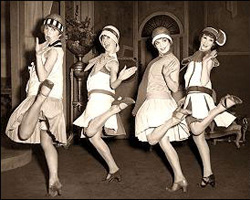
"Flappers"
The image of the 1920s as a decade of prosperity, of flappers and hot jazz, is largely a myth, even in the eyes of the writer who coined some of those terms. In his article "Echoes of the Jazz Age," F. Scott Fitzgerald wrote: "It was borrowed time anyway – the whole upper tenth of a nation living with the insouciance of a grand duc and the casualness of chorus girls."
There is some truth to the decade's image of prosperity but, as Fitzgerald notes, it was concentrated at the top. Six million families made less than $1,000 a year. According to the Brookings Institution, one-tenth of 1 percent of families at the top took in as much income as 42 percent of families at the bottom. In New York City, millions of people lived in tenements condemned as firetraps. When Fiorello La Guardia, a Congressman from East Harlem, toured the poorer districts of New York in 1928, he reported: "I confess I was not prepared for what I actually saw. It seemed almost incredible that such conditions of poverty could really exist."
- F. Scott Fitzgerald Additional Papers (web site)
- Flappers (video)

The Ku Klux Klan march in Stocktan, California, during the 1920s.
Labor strikes broke out, pitting coal miners and railroad men against their powerful employers. Burton Wheeler, a Senator from Montana, visited one of the strike areas: "All day long I have listened to heartrending stories of women evicted from their homes by the coal companies. I heard pitiful pleas of little children crying for bread. I stood aghast as I heard most amazing stories from men brutally beaten by private policemen."
There was a sweeping crackdown on immigration. New quotas were established that heavily favored Anglo-Saxons. China, Bulgaria, Palestine and the African nations could send no more than 100 people. England and Northern Ireland could send 34,000, while Italy could send just under 4,000.
Fitzgerald and Sinclair Lewis were part of a generation of writers, artists and musicians who were among the most innovative in the country's history. Traditional taboos concerning sex and gender politics were challenged. The country went dry on January 16, 1920, after Prohibition was successfully linked with Progressive Era causes, such as reforms to end wife beating and child abuse.
- Prohibition rises (video)
- Prohibition fosters organized crime (video)
- Sinclair Lewis (PDF)
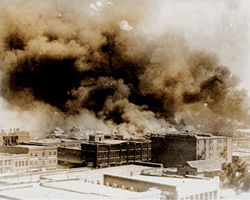
The African-American district burns during the Tulsa race riots of May, 1921.
The 1920s also saw a rise in tension between whites and blacks. In May of 1921, a large section of Tulsa was burned to the ground and a number of blacks and whites were killed. Some of the worst racial violence in American history took place during the 1920s. On the first day of 1923, a white mob searching for an alleged rapist burned all but one building in the tiny black settlement of Rosewood, Florida. Millions of blacks moved to northern cities. Soon, the black population of Chicago had swelled by 148 percent, Detroit's by 611 percent. Many cities adopted residential segregation ordinances to keep blacks out of white neighborhoods.
The United States became a consumer society in the 1920s. The automobile was its symbol; by 1929, there were 27 million autos on America's roads. Cigarettes, cosmetics and synthetic fabrics became staples of life. The rise of radio and the talking motion pictures (90 million Americans were going to them weekly) helped create a new popular culture that disseminated common speech, dress and behavior.
- The Ku Klux Klan rises (video)
- Timeline of the Tulsa Race Riot (web site)
Media moments
1920 — KDKA, the first official radio station

Frank Conrad of Pittsburgh, Pennsylvania, first started experimenting with the recently invented medium of radio in 1912. At the time, the technology primarily functioned as a means of naval communications; a lesson learned from the sinking of the Titanic. As the public began purchased amateur radios, Conrad's broadcasts became popular. Conrad is credited with inventing radio advertising when he started mentioning the name of the store giving him new records to play on the air. Westinghouse Electric Company, Conrad's employer, recognized the potential of his hobby and began manufacturing and selling more radio receivers. On October 27, 1920, Westinghouse received the first formal license from the federal government to broadcast as a terrestrial radio station. Designate KDKA, the station gained instant success when it broadcast live results of the 1928 presidential election.The call letters, KDKA, carry no significance, and would have been awarded to a naval station had Westinghouse and Conrad not discovered a new use for the technology.
- KDKA comes alive (video)
1924 — Leopold and Loeb

Another "trial of the century." The two teenagers from highly privileged Chicago families, Nathan Leopold and Richard Loeb, kidnapped, killed and mutilated a 14-year-old neighbor. The case challenged previously held notions of juvenile killers with below-average IQs. Leopold would describe the pair as evil geniuses who were above normal standards of morality. Their attorney, Clarence Darrow, introduced the psychiatric defense into the legal system. The jury and the press accepted Darrow's argument that society, schools and violent social conditions were to blame, and the killers avoided execution.
1925 — Scopes Monkey Trial

Fundamentalist-christians introduced 37 anti-evolution bills to 20 state legislatures during the 1920s, and the first one to pass was in Tennessee. Taking up the ACLU's offer to defend anyone who violated the new law, Dayton, Tennessee, booster George Rappleyea realized the town would get all kinds of publicity if a local teacher was arrested for teaching evolution. He enlisted John Scopes, a science teacher and football coach. The trial was marked by a carnival-like atmosphere; for 12 days, 100 reporters sent dispatches from Dayton. Scopes' $100 fine was later thrown out on a technicality. It went down in history and literature as one of America's best-known trials and symbolized the conflict between faith and reason.
May 21, 1927 — Lindbergh's flight

25-year-old Charles Lindbergh completed the first solo nonstop transatlantic flight in history in "The Spirit of St. Louis." The trip was 3,610 miles, beginning from Roosevelt Field on Long Island and ending in Paris after 33 hours and 30 minutes. The aftermath was what came to be known as the "Lindbergh boom" in aviation: industry stocks rose and interest in flying skyrocketed. Lindbergh's subsequent U.S. tour demonstrated the potential of the plane as a safe and reliable mode of transportation.
- Lindbergh history -- The Charles A. and Anne Morrow Lindbergh Foundation (web site)
- Test flight (video)
- Lindbergh's historic takeoff (video)
- Parades greet Lindbergh (silent video)
1928 — Ruth Snyder Executed

Ruth Snyder, a discontented Long Island housewife, convinced her lover, Judd Gray, that her husband was mistreating her. The pair killed him with a sash weight. Their trial was a media frenzy, attended by such celebrities as film pioneer D.W. Griffith and evangelist Billy Sunday. The jury was out 98 minutes before it returned with a guilty verdict. Gray was executed first on January 12, 1928. Snyder followed just a few minutes later. A clever photographer from the New York Daily News, with a camera strapped to his ankle, snapped a picture of her as the juice coursed through her body. It sold 250,000 extra copies and is the iconic image of the 1920s.
October 29, 1929 — The Stock Market crashes

Heavy speculation on in stocks cause a bubble which burst in October. Fortunes were lost almost instantly. Breadlines filled with the unemployed and the homeless become commonplace. This unprecedented downturn in the economy would cause stagnation and strife around the world. The Roaring Twenties come to screeching halt and the Great Depression settled in, dominating the 1930s.
Trends in journalism
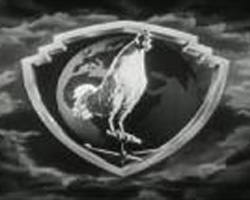
The silent newsreels first produced by Pathe Weekly in 1911 became hugely popular talkies when Theodore Case developed his sound-on-film system.
The shift from print-based journalism to electronic media began in the 1920s. Competition between newspapers and radio was minimal, because the latter was not yet an effective news medium. People listened to radio bulletins, but to "read all about it" they picked up a tabloid or a broadsheet.
The New York World was generally known as the best paper of the decade. Regarded as "the newspaperman's newspaper," it was, in stature, the New York Times of its day, relying on solid reporting and writing instead of broad coverage. The paper's lauded and independently liberal editorial page was edited by Walter Lippmann, who became one of the most influential American writers of the century. The paper's merger into the World-Telegram is seen as a black day in newspaper history.
The talkie newsreel was born when Theodore Case developed his sound-on-film system. The Fox Film Corporation bought Case's system in 1926 and developed Fox Movietone News. The first talkie newsreel showed Charles Lindbergh taking off on his transatlantic flight on May 20, 1927. Its enormous success compelled other studios to produce competing newsreels. They became so popular that theaters showing only newsreels opened in major cities around the country.
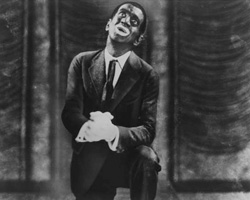
Al Jolson, a white man, performing in "blackface".
Radios were first marketed for home use in 1920. By 1929, they sold 5 million sets every year. RCA's Radiola was the most widely advertised model, selling for $35. RCA formed the National Broadcasting Company, which had its first broadcast on November 15, 1926. Programming remained unimaginative until the end of the decade, relying on speeches, lectures (on such topics as basket weaving) and music. In 1925, more than 70 percent of air time was devoted to music; less than 1 percent was devoted to news. By 1929, 40 percent of the population owned radios, tuning in to hear music, sports scores, Al Jolson (the decade's top star) and Amos ‘n' Andy.
Jazz journalism brought with it sensational stories printed in a popular tabloid format. Modern media's obsession with sex and crime has nothing on the era's scandalous content. Stories such as the 1922 Hall-Mills case (involving the murder of a minister and a choir singer) and the 1927 Snyder-Gray case (involving the murder of a husband by an adulterous wife) gripped the nation. Competing tabloids included Joseph Medill Patterson's The New York Daily News, William Randolph Hearst's The New York Daily Mirror, and Bernarr Macfadden's New York Evening Graphic, also known as the "Porno-Graphic."
Modern advertising took root in the 1920s when advertising agencies started to take shape.
- The birth of modern advertising (video)

